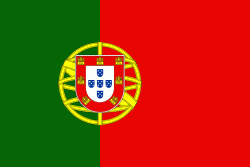Abrantes Municipality (Abrantes)
 |
 |
The Celts are believed to have established the first settlement in Abrantes around 300 BC. The name is derived from Latin Aurantes, perhaps referring to deposits of alluvial gold (Latin: aurum) along the Tagus. Similarly, Roman mosaics, coins, the remains of ancient aqueducts, as well as other antiquities, have been discovered in the vicinity of Abrantes.
The village of Abrantes and the Abrantes Castle were conquered from the Moors by Afonso I of Portugal in 1148. After 1172, Abrantes was a military outpost, under the dominion of the Order of Saint James of Compostela. In 1173, the region, including its castle, were donated to the Order of Saint James of the Sword, a distinct order. Pope Nicholas IV (around 1290) released this Order from the jurisdiction of the Castilian grand master of Santiago de Compostela Order in Uclés. It received its municipal foral in 1179, in compensation for its resistance against the Moroccan Abem Jacob. Its creation in 1179, was based on the concelhos perfeitos ("perfect municipality") model; they were formed on the specific day that settlers were invited to populate them; the administrative regime, the organization of the municipal authority and geographic distribution were planned as part of system of populating uninhabited lands, and extending the political influence of the Kingdom. Its geography contributed to the colonization: "Zone of permanent conflicts, where the Reconquista came to pontual conclusion, the colonization of Monte Abrantino was facilitated by the geographic situation of the mount, situated to the north of the Tagus, which served as a natural frontier and protected it from incursions; the Tagus which was an important source of richness (water, fish, gold, navigation, etc.), a mount situated in the confluence and transition of territories, crossroads of trails between south and norther, free of overflows, with persistent fog, cleansed of good aires, all these were conditions that,...gave the location the conditions necessary to attract colonists, colonization that, it seems, not to have been easy..."
On 24 April 1281, King Dinis of Portugal, conceded the ownership of Abrantes to Queen Elizabeth of Portugal.
Afonso IV of Portugal transferred the title of the religious parish to the Knights Hospitaller, in 1327, and granted Abrantes to Leonor Teles. Partners of the Master of Avis, the Abrantinos were one of the first to support the Lisboete movement of 1383, among them Fernando Álvares de Almeida, protector of the Casa de Abrantes.
King Manuel stayed in Abrantes for a long period; by 1510 he conceded a new foral to the town; and his children, the Infantes Fernando and Luís were born in Abrantes. During the 16th century, Abrantes and its religious parish was one of the largest and more populous lands in the Kingdom, with 3,436 inhabitants, four convents and 13 chapels or churches within its frontiers.
In 1581, in his move to Tomar, Philip I of Portugal stopped in Abrantes for several days, and during his reign was responsible for the reconstruction of Abrantes' municipal buildings. It was the seat of Portuguese marquesses, one of which was an early patron of the Brazilian-born versatile scientist, naturalist and pioneering inventor-aeronaut Bartholomeu Lourenço de Gusmão.
During 1640, Abrantes was one of the first lands to declare their support for John IV of Portugal. From the 17th and 18th centuries onwards, its ancient military importance was confirmed, as it was used by Portuguese and foreign armies to garrison or concentrate their forces. The village of Abrantes was captured on 24 November 1807 by French general Jean-Andoche Junot, who was awarded a ducal title for his victory by Napoleon I in 1808, and used as base for further marshaling of French forces. In the Convention of Cintra (22 August 1808) the town was returned to the Portuguese.
During the reign of Joseph I (1750–1777) the village became the center of the silk industry, which prospered until 1800, designated the Academia Tubuciana.
In 1820, Abrantes supported the Liberal Revolution and celebrated the 1822 Constitution; although Miguel of Portugal did find many supporters in the municipality, no outright manifestation of support occurred in light of the Vilafrancada. In November 1862, the Santerém-Abrantes lines was opened, and by March 1868, a bridge between Abrantes and Rossio to the southern Tagus region was well underway.
Map - Abrantes Municipality (Abrantes)
Map
Country - Portugal
 |
 |
| Flag of Portugal | |
One of the oldest countries in Europe, its territory has been continuously settled, invaded and fought over since prehistoric times. The territory was first inhabited by pre-Roman and Celtic peoples who had contact with Phoenicians, ancient Greeks and Carthaginians. It was later ruled by the Romans, followed by the invasions of Germanic peoples and the Islamic invasion by the Moors, whose rule was eventually expelled during the Reconquista. Founded first as a county of the Kingdom of León in 868, gained its independence as the Kingdom of Portugal with the Treaty of Zamora in 1143.
Currency / Language
| ISO | Currency | Symbol | Significant figures |
|---|---|---|---|
| EUR | Euro | € | 2 |
| ISO | Language |
|---|---|
| PT | Portuguese language |















